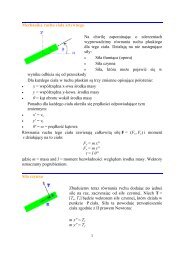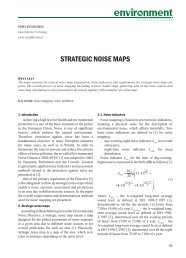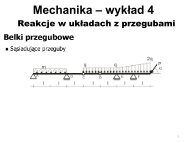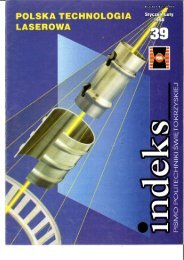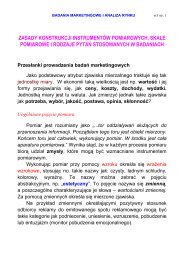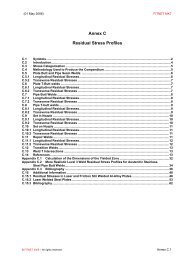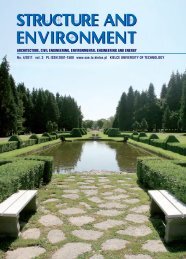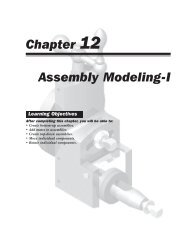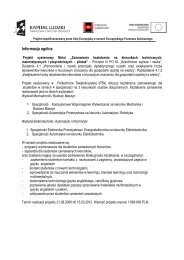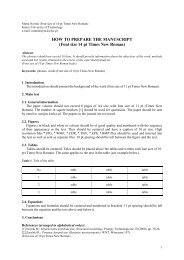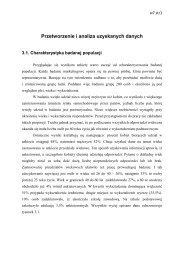ROAD SUBGRADE EMBANKMENT DEFORMATIONwith asphalt <strong>and</strong> cement-concrete pavements at thecarriageway <strong>and</strong> shoulders, with good grassy turfsat the slopes. Particularly often these deformationsoccur in the first 1-3 years of grade level service.The possible schemes of local deformationdevelopments are presented at the Figure 2. In allcases there are slip lines of the definite coat massif ofsoil in the coating surface of the slope:The condition of the slope stability is the balanceor excess of restraining forces over the shear forces.Stability coefficient is:, (1), (2)where: γ – soil density; Zi – running coordinate ofthe active zone capacity of the slope perpendicularlyits surface; tgψ Zi– coefficient of soil shift of theactive zone h at depth Zi; tgφ n, C n– correspondinglycalculated values of angle of repose <strong>and</strong> soil cohesionat depth Zi; α – rate of slope.а)b)c)Fig. 2. Development scheme of shear deformations on thefill slopes [6]: а) due to identity element; b) inplane slipwith uplift; c) destruction of the whole slope in the belt ofweathering on the circular cylindrical surface; 1 – face ofslope; 2 – capacity of the active zone ha; 3 – shift surface;4 – assumed blocks; 5 – retaining prism in uplift zone2.1. The water <strong>and</strong> it role in losing stability of the slopeThe analysis of the complex of restraining forceshowed that, the main role in the loss of local soilstability on the slopes is played by water, whichcauses decreasing of angle of repose <strong>and</strong> cohesionbetween the particulates <strong>and</strong> dynamically effects thesoil grains.Structural cohesion С nin graded materials takesplace only in case of high density <strong>and</strong> soil compactness<strong>and</strong> predominantly in case of low homogeneity ongrain-size classification <strong>and</strong> is predetermined, mainly,by interlocking grain arrangement [9].Table 1. Dependence of cohesion <strong>and</strong> angle of internalfriction of soil from its porosity [9]Cohesion С (МPа) <strong>and</strong> angle ofType of refuse stoneinternal friction j (grade) with theporosity factor e0.45 0.55 0.65 0.75Gravel <strong>and</strong> coarse s<strong>and</strong>0.02 0.01 – –43 40 38 –S<strong>and</strong>s of average coarseness0.03 0.02 0.01 –40 38 35 –Fine s<strong>and</strong>0.06 0.04 0.02 –38 36 32 28Dust s<strong>and</strong>0.08 0.06 0.04 0.0236 34 30 26Note: Upper line – cohesion, lower – angle of repose.The water gets into the soil on the slopes as a resultof percolation in case of storm event <strong>and</strong> snow melting.In winter the soil of grade level freezes (after thetemperature fall below -5°С). Isothermal curve of zerotemperature falls lower <strong>and</strong> lower from the surface of33
M. V. Nemchinov, A. S. Men’shovgrade level. Temperature distribution in depth givesevidence of the character of the soil straight-freezing:maximal under the roadway paving <strong>and</strong> lesser on theslopes of fills (Fig. 3 [8]).Isotherm of Februaryat the slope surface reaches the value, wherein theall amount of melt-water which enters the soil goesto the soil pores. The flow down the surface of theslope stops. Melt-water through the soil pores underthe gravity forces reaches the surface of the soil stillnot melted. In case of quite a large openness thereappears the water flow in the soil. Gradually takesplace the formation of seepage, which flows in thesoil above the border of the section «thawed ground– frozen ground» (Fig. 4).Isotherm of MarchIsotherm of AprilFig. 4. Formation of the seepage on the slopes of thegrade level during the snow meltingFig. 3. Isotherms (°С) of the coat of grade level during thewinter-spring months (Moscow <strong>and</strong> Moscow region)In spring there is started a constant soil temperaturerise in the upper part of the grade level. Heat currentchanges its direction, moreover before the start ofmelting. Soil frost retreat starts from two sides: fromabove, from the surface of grade level, <strong>and</strong> frombelow, from the side of thawed ground (in the messor the ground of the grade level). The speed of frostretreat from above is more or less identical on all theareas <strong>and</strong> averages (for Moscow region) to 4 cm/day.Frost retreat from within averages to 0.6-0.7 cm/day.On the whole the thickness of layer, melted fromwithin, amounts – in relation to the whole thicknessof frost-bound layer – to 7 up to 34%.After the start of snow melting the water fromthe upper coating of the snow cover, subject to theforces of gravitation, passes through the snow to thesoil slope. Under the influence of melt-water thereis started gradual coat frost retreat. The part of meltwatergets into the pores of the unfrozen soil, theremaining part flows through the slope – throughthe face of slope, under the snow cover. As the snowmelts <strong>and</strong> the soil thaws the major part melt-watergets into the soil pores <strong>and</strong> the smallest part of itflows down the slope surface. At last there comesa moment, when the depth of the melted soil-workAs a result there happens a considerable soiloverwetting, followed by the decrease of forces,which secure the soil grains from the shift. In thezone of water filtration on soil grains operates thehydrodynamic head h B, which appears as the result ofpenetration of elementary rate of water flow q, <strong>and</strong> thefollowing formation of seepage with the rate Q = Σq i.Elementary rate of flow qi is formed by water, whichpenetrates into the soil during the snow melting onthe slopes, <strong>and</strong>, in case of storm event, rainwater.The water flows through the surface of aquifuge –the surface of still frozen soil-work (in spring) or thesurface of a more solid soil-work which lies lower (insummer <strong>and</strong> in autumn).The melting surface is not plain. That is why insome places, because of the outflow obstacle, the localadditional body of water may occur, which increasesweighing water impact <strong>and</strong> therefore decreasesrestraining forces.The water of rains which fall during the snowmelting period accelerates <strong>and</strong> increases the processof snow melting, therefore leveling up the water flowin the coat. The rainwater itself also penetrates intothe soil pores (because of the infiltration) increasingmore the filtration flow <strong>and</strong> soil dampness. Becauseof the accelerated snow melting <strong>and</strong> soil frost retreatin the zone of the shelf of grade level there is possible34




